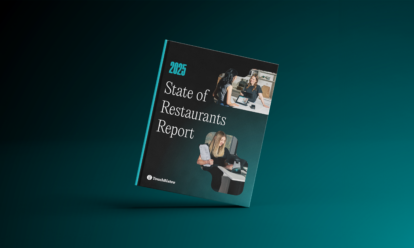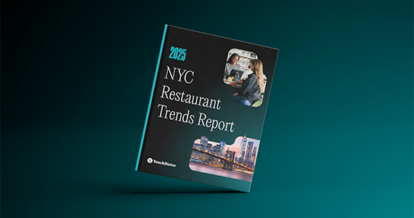Excellent customer service is at the heart of every satisfying restaurant experience. You strive to provide the right menu, service, and ambiance to inspire loyalty and devotion in your customers.
But what about the way customers pay? Is that part of your customer experience equation?
It should be.
More and more Americans – particularly notoriously foodie-minded Millennials and Generation Zers – prefer to use their debit or credit card to pay for everything, from their morning latte to an extravagant eight-course tasting menu. In fact, a 2017 Statista survey found that 34% of respondents use a debit or credit card most of the time and only occasionally use cash.
The American Banking Association reported there were 374 million open credit card accounts in the U.S. as of 2019. And with the rising popularity of digital payment processing, consumers are demonstrating that choice and convenience is important to them when it comes to purchasing.
If you want to accommodate more than just your diners’ palates, it’s clear that providing them with a simple, convenient, and secure way to pay is becoming increasingly critical.
One easy way to do that is to work with a restaurant merchant services provider that offers integrated payments and can provide you with the option to pay at the table. Restaurant customers can zip through the payment process quickly using any type of card payment method they choose. Your servers can do their jobs more efficiently. And everyone benefits from increased security.
In this article, we’ll run through some compelling reasons to upgrade the payment experience in your restaurant to include pay at the table technology. You’ll find out exactly what’s in it for your customers, your staff, and your business.
Are you open to innovation, but not sure what system to use? We break down those choices, too.
Disclaimer: All of the information contained in this article is for informational purposes only and does not constitute legal, accounting, tax, or other professional or compliance advice. It is your responsibility to determine whether credit card surcharging is permissible in your jurisdiction. You are solely responsible for ensuring that your activity is compliant with the card network requirements and all laws applicable to you. Non-compliance may result in regulatory consequences or fines.
Why Pay at Table?
If you’re interested in efficiency, it pays to take a closer look at the difference between a fixed and pay-at-table experience.
| Payment with a Fixed Terminal | Pay at Table |
|---|---|
| 1. The server prints the check and delivers it to the customer in a billfold. | 1. The server prints the check and delivers it to the customer in a billfold. |
| 2. The diner reviews the check and puts down their card. | 2. The diner reviews the check and puts down their card. |
| 3. The server returns to the table, removes the card from the portfolio, and takes it back to stationary credit card reader. | 3. The server returns to the table with the wireless terminal and offers it to the customer who enters the tip then swipes, dips, taps, or hovers their card or mobile wallet to pay. A receipt is printed at the table. The sale is complete and the table is closed out. |
| 4. At the fixed terminal, the server processes the card, prints the receipt and returns to the table for the customer to write down the tip. | |
| 5. The customer calculates a tip, signs the receipt, and leaves the restaurant. | |
| 6. The server returns to the terminal with the billfold again to enter the tip and close out the sale. |
A six-step process is cut in half with restaurant pay-at-table technology.
And that’s not counting the physical steps it saves the server who doesn’t have to criss-cross the restaurant several times to ring just one check through on one of the restaurant’s stationary credit card readers!
Time savings are just the beginning. Restaurant mobile payment offers plenty of other advantages for both diners and restaurant owners.
4 Benefits of Pay at the Table: Customers
There’s a reason that modern consumers are embracing new payment processing technology at rapid rates around the world. Here’s why pay-at-the-table technology is especially good for your customers.
1. Security
The more sophisticated the payment technology, the lower the risk of fraud. When they pay at the table with their credit card using chip and PIN, EMV and sign, or mobile payments, your customers have the peace of mind that comes with watching the entire payment transaction unfold before their eyes.
2. Faster Service
Even the most dedicated foodies are usually ready to swiftly exit after the bill arrives. Waiting around for the server to come back for the bill fold, process the transaction at a fixed terminal, and come back again can feel like an eternity – especially if it’s a busy night or if diners want to head out. When they know they can settle up quickly, customers are more likely to make repeat visits.
3. Easy Tip Calculation
Who likes a side of math with their meal? Exactly no one. Calculating a reasonable tip is a pain that often requires mental gymnastics or the discreet services of your phone’s calculator. That kind of hassle is eliminated with a pay-at-table device. Most terminals offer diners the option to tip by percentage or dollar amount, further reducing the time it takes to take care of their bill. This kind of flexibility and convenience helps your customers stay focused on the sweet satisfaction of the meal they just enjoyed.
4. No Wallet Required
People with mobile wallet apps on their phones may leave their actual wallet at home without a second thought. If they know they can make purchases digitally, it’s not necessary to weigh themselves down. However, this means they’ll keep on walking if your restaurant doesn’t have pay-at-table technology that allows them to settle up with their mobile wallet.
5 Benefits of Pay at the Table: Restaurants
Think your customers reap all the rewards of paying at the table? Think again. Your staff and restaurant have a lot to gain too.
1. More Tables Turned
Remember that six-step payment process that was cut in half? Hospitality Technology estimates that moving from three to four table turns per shift can increase revenue by 20% to 25%. This efficiency means your staff exert less energy to do their job, which they can then channel into providing authentic customer service with even more diners each shift.
2. Higher Tips
When you reduce the time and hassle associated with payment, diners and servers don’t have short, choppy interactions at the end of the meal. One efficient payment process at the end means they can keep great customer service going, which can increase the chance of a great tip. And the tip calculating feature helps math-challenged people to leave a proper 15% to 20% (or more) tip. Better tips make for happier, more engaged employees.
3. Reduced Risk of Employee Fraud
You can enjoy the same peace of mind your diners experience when you consider the security benefits associated with pay-at-table terminals. With the entire process taking place right in front of the customer, there’s considerably less opportunity for credit card fraud or employee theft. You can put your focus on training your staff to be great employees instead of trying to weed out possible fraudsters on the payroll.
4. Fewer Chargebacks
According to Hospitality Tech, chargebacks have been on the rise since the liability shift in October 2015 and restaurants are at the top of the list of businesses affected. Why? Because more merchants now use EMV, fraudsters have moved to industries with slower adopters (i.e. the restaurant business) because – without the new security – they’re easy targets. It’s all about a trickle-down effect.
But chargebacks can also happen just due to human error. A server who’s multitasking on a busy night is more likely to punch in the wrong amount when entering a tip at a fixed terminal.
By automating the process with the wireless terminal at the table, the risk of error AND fraud are drastically reduced, and you can avoid the aggravation (and cost!) that goes with a chargeback.
5. Less Paperwork
Pay-at-table terminals makes it easy to tally and record your sales at the end of a server’s shift and at closing time. With everything digitized, it’s a matter of pressing a few buttons to bring everything together into neat financial reports. No calculations or reams of receipts to process. You’ll save time and paper – good for you and the environment.
Best Practices for Introducing Pay at the Table in Your Restaurant
Implementing new technology always comes with a learning curve. When it comes to pay-at-table terminals, it’s a pretty small one. Most interfaces are intuitive, guiding servers and customers alike through the process of completing a transaction.
Still, make sure your employees are clear about how to use terminals (if you have younger workers, they’ll pick it up in seconds) and can help their customers – and each other – if they get stuck. It’s also important that they share the benefits of the new technology to reluctant diners, including added security, faster service, and help calculating the tip.
Coach staff to be patient and helpful with technology-averse diners. This might mean handing them the terminal and saying, “Just follow the prompts and I’ll be right back.” Others may need more guidance as they work through each step. If your demographic is mostly seniors, consider creating a one-pager with pictures of each step and having it available for people who prefer to learn visually. It might be helpful to point out that if you can use an ATM or an iPad, you can pay at the table.
How to Choose the Right Pay-at-the-Table System for Your Restaurant
When deciding if you want to let customers pay at the table, you also have to decide how they can do this.
The three most popular options are:
- Portable wireless terminals, such as Ingenico or Verifone device
- Stand alone, bluetooth-enabled devices, like the Ingenico Moby 8500
- POS integrated, bluetooth-enabled devices, like the integrated Ingenico 457c card reader
There are also external factors to consider with each option. Consider these when choosing the right solution for your restaurant:
1. Cost
Merchant credit card fees isn’t the only cost to take into account.
Portable wireless terminals are more expensive (approximately $700 to $1,200) compared to a card reader (around $300) or a POS terminal that attaches to a tablet or phone (roughly $100). For the latter two options, you also need to factor in the cost of the technology. It may be worth a conversation with a payment processor to learn about your options and what other restaurants of your size are finding success with.
2. Layout of Restaurant
Bluetooth technology is fast and efficient – except when it’s out range from the device it’s connected to, which happens in certain sections of a restaurant – like outdoor patios. Wireless terminals connect to WiFi or a 3G network that would use the cellular network to connect with fewer opportunities for service interruption. Assess your restaurant’s receptiveness to connectivity. And, in the worst case scenario of losing your network completely, the right solution should still be able to process payments offline.
3. Customer Demographic and Preferred Guest Experience
Consider the people who will regularly use pay-at-the-table technology. Is damage a risk if you’re passing an iPad around the table? Will most of your guests understand how to use the technology or will they need coaching? Is one wireless terminal enough to be carted around and shared among servers?
There are very few restaurants that can get away with being charming or niche enough to limit their customers’ choices when it comes to payment processing. Modern consumers demand the technology that’s readily available to them everywhere else.
After all, the customer is always right. Right?
Learn how to save money on payment processing fees
Sign up for our free weekly TouchBistro Newsletter







